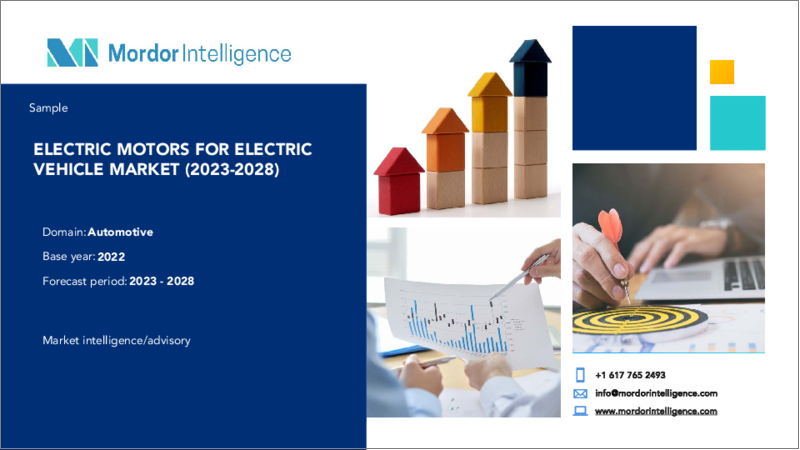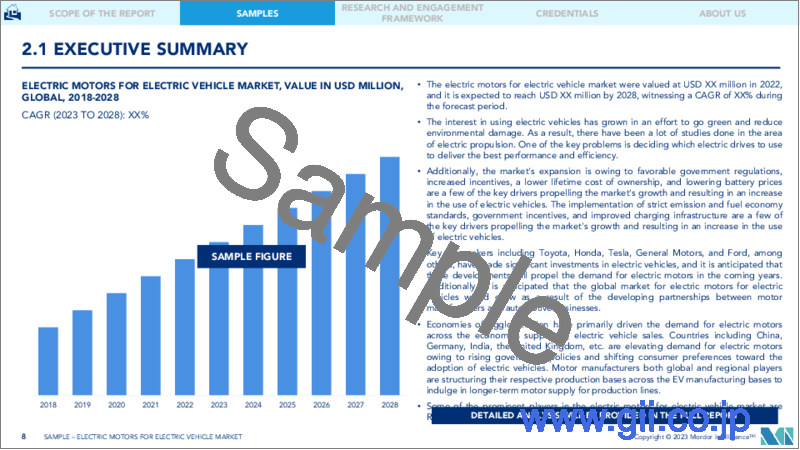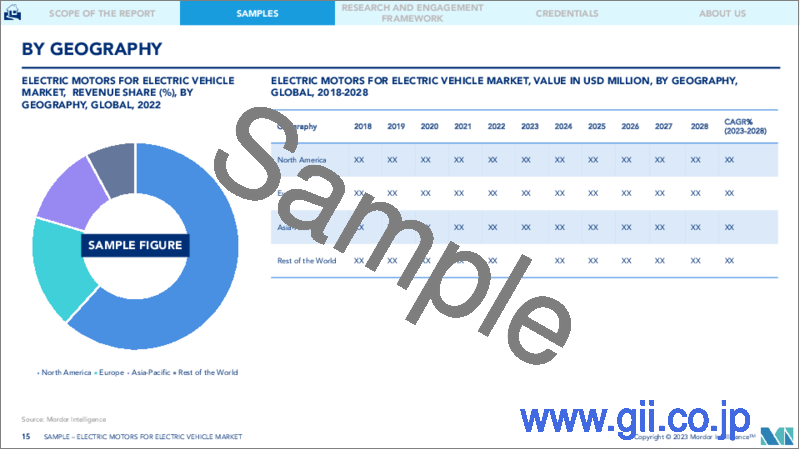|
|
市場調査レポート
商品コード
1190692
電気自動車用電気モーター市場- 成長、動向、予測(2023年~2028年)Electric Motors For Electric Vehicle Market - Growth, Trends, and Forecasts (2023 - 2028) |
||||||
|
● お客様のご希望に応じて、既存データの加工や未掲載情報(例:国別セグメント)の追加などの対応が可能です。 詳細はお問い合わせください。 |
|||||||
| 電気自動車用電気モーター市場- 成長、動向、予測(2023年~2028年) |
|
出版日: 2023年01月18日
発行: Mordor Intelligence
ページ情報: 英文 90 Pages
納期: 2~3営業日
|
- 全表示
- 概要
- 目次
電気自動車用電気モーター市場は、現在、48億米ドルとなり、予測期間中に28.63%のCAGRで推移すると予想されています。
COVID-19は、製造停止、ロックダウン、貿易制限を引き起こし、2020年前半の電気自動車用電気モーターに悪影響を及ぼしました。しかし、COVID-19後の回復、厳しい自動車排出ガス規制の採用、電気自動車の早期導入のための政府の手厚いインセンティブの提供により、電気自動車の販売は非常に健全な上昇を見せました。さらに、電気自動車用の電気モーターの販売も大きく伸びました。例えば、2020年の電気乗用車の販売台数は、2019年比で39%増の310万台に跳ね上がりました。
さらに、メーカーは、自動車産業の重要な分野の顧客との継続性を保持するために、製造およびサプライチェーンを多様化することで、将来のビジネスの不確実性を軽減するコンティンジェンシー・プランを実施しました。例えば、以下のようなものです。
主なハイライト
- 2020年2月、Brose Fahrzeugteile SE &Co.KGは、インドのプネー近郊のヒンジェワディに新キャンパスを開設しました。新拠点では430人を雇用する予定です。Brose Fahrzeugteile SE &Co.KGは、今後インドに6000万ユーロ(6240万米ドル)を投資すると発表しました。
長期的には、厳しい排出ガス規制や燃費規制、政府による奨励措置、充電インフラの整備などにより、電気自動車の販売が増加していることが、調査対象市場の成長を促す主な要因の1つとなっています。トヨタ、ホンダ、テスラ、ゼネラルモーターズ、フォードなどの大手自動車会社による電気自動車への大規模な投資は、間もなく電気モーター市場を牽引すると予想されます。さらに、モーターメーカーと自動車会社の間のパートナーシップの進化は、調査された市場を世界的に拡大すると予想されます。
地理的には、アジア太平洋は、中国やインドなどの新興市場の存在により、予測期間中に最大の電気モーター市場になることが期待されます。欧州は、政府の二酸化炭素排出量抑制策により、市場開拓の原動力となっています。英国、ドイツ、フランスは同地域の市場拡大に貢献しています。
このように、上記の要因が電気自動車用電動機市場の成長をさらに後押ししています。
主な市場動向
電気自動車に対する需要の高まりが市場の成長を後押し
中国、米国、日本、韓国、欧州における電気自動車の販売台数の急増により、電気モーターに対する需要は飛躍的に増加すると予想されます。電気自動車は、各国政府が電気自動車普及のために提供するインセンティブ、一般的な自動車購入者の環境意識の高まり、燃料価格の上昇などにより、世界中で爆発的に販売台数が伸びています。また、従来の内燃機関車よりも電気自動車の方がランニングコストが低いことや、中国やEUの政府が2035年までに内燃機関車による移動を禁止することを発表したことも要因となっています。例えば
- 2021年、世界で690万台の電気自動車が登録され、前年比107%増となっています。
電気自動車用電気モーターの成長を促す主な要因は、電気自動車の走行距離を向上させる需要の増加であり、ひいては電気自動車用電気モーター市場の成長にプラスの影響を与えると予想されます。
さらに、世界各国の政府も電気自動車の普及を促進するための政策を積極的に打ち出しています。中国、インド、フランス、英国は、2040年までにガソリン車とディーゼル車を完全に廃止する計画を発表しています。例えば
- 2022年10月、欧州連合はEU加盟国において2035年から内燃機関車の新車販売を禁止することを発表しました。
- 欧州は、2050年までに気候ニュートラルになるという高い目標を発表しました。欧州委員会は今後数年間、この目標を達成するための新たな立法案をいくつか発表する予定です。その多くは、モビリティの向上を目的としたものです。この目標を達成するためには、国家、企業、消費者を正しい道へと導く一連の政策と目標が必要です。欧州委員会は、7,500億ユーロ(7,800億米ドル)のCOVID-19刺激策の中で、200億ユーロ(212億米ドル)をクリーンモビリティの迅速かつ広範囲な導入に充当しています。2030年までにEU域内で電気自動車3000万台、水素自動車100万台を含むクリーンカーの販売促進を発表しました。
- 2022年9月、中国は、バッテリー電気自動車、ハイブリッド車、プラグインハイブリッド車、水素燃料電池車などの新エネルギー電気自動車に対する5%の購入税の免税措置を2023年末まで延長したと発表しました。
- 2021年、インド連邦政府は、ハイブリッド車・電気自動車の早期導入・製造(FAME)計画の第2段階を2年延長し、2024年3月31日までとすることを発表しました。この計画は、電気自動車の導入販売と電気自動車に関連する部品の製造を促進することを目的としています。
また、政府や非公開会社は、排出ガスを最小限に抑え、環境に配慮した充電インフラを世界中に構築する意向です。このように、電気自動車の需要の高まりは、自動車への電気モーターの採用をさらに悪化させ、予測期間中に電気モーターの製造を増大させます。
アジア太平洋地域が市場を独占すると予想される
世界的に見ると、アジア太平洋地域は、中国を中心とした電気自動車の高い販売量により、電気自動車用電動モーターの市場で最大のシェアを獲得しています。アジア太平洋地域では、中国とインドが電気自動車の主要な製造国および消費国となっています。中国とインドでは、国家的な販売目標、有利な法律、自治体の大気質目標が国内需要を支えています。例えば
- インド政府は、2022年までにFAME II(Faster Adoption and Manufacturing of Hybrid Electric Vehicles)の下、今後3年間で7000台のeバス、50000台のe3輪車、55000台のe4輪車乗用車(強力ハイブリッド車を含む)、10000台のe2輪車を導入することを発表しました。FAME II(Faster Adoption and Manufacturing of Hybrid Electric Vehicles)には1億インドルピー(12億米ドル)が割り当てられました。
- 中国は、電気自動車やハイブリッド車のメーカーに、新車販売台数の10%以上を占めるという枠を課しました。また、北京では、住民の電気自動車への切り替えを促すため、内燃機関自動車の登録許可証は月に1万台しか発行していません。
これらの国々では、電気自動車も年間販売台数を大きく伸ばしており、電気モーター市場の成長をさらに後押しすることになるでしょう。例えば
- 中国では2021年に299万台の乗用車用電気自動車が販売され、前年比169.1%増、インドでは2021年に17802台の電気自動車が販売され、前年比168%増を記録しています。
したがって、上記の要因により、アジア太平洋は電気自動車用電気モーター市場の最も支配的な地域であることが維持されると予想されます。
競合情勢について
電気自動車用電気モーター市場は、多くの地域的および国際的なプレーヤーが存在するため、適度に統合されています。いくつかの重要なプレーヤーは、Bosch Mobility Solutions、ABB、Nidec Corporation、Brose Fahrzeugteile GmbH &Co.KG、Johnson Electric Groupなどです。これらのプレイヤーの多くは、市場での地位を固めるために、ジョイントベンチャー、M&A、新製品の発表、生産能力の拡大などに取り組んでいます。例えば
- 2022年12月、インドの自動車部品メーカーであるShriram Pistons Ltd.は、シンガポールに拠点を置くあらゆるタイプの電気自動車向け電気モーターの設計・製造会社であるEMF Innovationsの株式の過半数を取得すると発表しました。Shriram Pistons Ltdの100%子会社であるSPR Engineousが取引を行うことになります。この取引でEV市場に参入し、すべてのEV市場セグメントに対応します。
- 2022年10月、Bosch Mobility Solutionsは、米国サウスカロライナ州のチャールストン工場で、ピックアップトラック「Rivian R1T」向けの電気自動車用電気モーターの生産を拡大するため、2億6000万米ドルを投資すると発表しています。
その他の特典です。
- エクセル形式の市場予測(ME)シート
- アナリストによる3ヶ月間のサポート
目次
第1章 イントロダクション
- 調査の前提条件
- 調査範囲
第2章 調査手法
第3章 エグゼクティブサマリー
第4章 市場力学
- 市場促進要因
- 市場抑制要因
- 産業の魅力- ポーターのファイブフォース分析
- 供給企業の交渉力
- 買い手/消費者の交渉力
- 新規参入業者の脅威
- 代替品の脅威
- 競争企業間の敵対関係
第5章 市場セグメンテーション
- アセンブリ
- ホイールハブ
- セントラルパワートレイン
- アプリケーション
- 乗用車
- 商用車
- モータータイプ
- ブラシレスDCモーター
- 永久磁石同期モータ
- 非同期モーター
- シンクロナスリラクタンスモータ
- その他(磁束無鉄芯永久磁石モータ、スイッチドリラクタンスモータなど
- 出力
- 100kWまで
- 101~250キロワット
- 250 kW以上
- 地域
- 北米
- 米国
- カナダ
- その他北米地域
- 欧州
- 英国
- ドイツ
- フランス
- イタリア
- その他の欧州地域
- アジア太平洋地域
- インド
- 中国
- 日本
- 韓国
- その他アジア太平洋地域
- 世界のその他の地域
- 南米
- 中東・アフリカ
- 北米
第6章 競合情勢
- ベンダーの市場シェア
- 企業プロファイル
- Aisin Seiki Co. Ltd
- Toyota Motor Corporation
- Hitachi Automotive Systems
- DENSO Corporation
- Honda Motor Company Ltd
- Mitsubishi Electric Corp.
- Magna International
- Robert Bosch GmbH
- BMW AG
- Nissan Motor Co. Ltd
- Tesla Inc.
- Toshiba Corporation
- BYD Co. Ltd
第7章 市場機会と今後の動向
第8章 免責事項
The Electric Motors for Electric Vehicle Market is currently valued at USD 4.80 billion and is expected to register a CAGR of 28.63% during the forecast period.
COVID-19 led to manufacturing shutdowns, lockdowns, and trade restrictions that negatively impacted the electric motors for the electric vehicle industry in the first half of the year 2020. However, the post-COVID-19 recovery, the stringent automotive emissions norms adoption, and the provision of generous government incentives for the quick adoption of electromobility led to a very healthy rise in the sales of electric vehicles. It further produced significant growth in the sales of electric motors for electric cars. For instance, in 2020, electric passenger vehicle sales jumped to 3.1 million units, an increase of 39% over 2019.
In addition, the manufacturers implemented contingency plans to mitigate future business uncertainties to retain continuity with clients in the critical sectors of the automobile industry by diversifying their manufacturing and supply chains. For instance,
Key Highlights
- In February 2020, Brose Fahrzeugteile SE & Co. KG opened its new campus in India at Hinjewadi near Pune. The new location will employ 430 people. Brose Fahrzeugteile SE & Co. KG announced an investment of EUR 60 million ( USD 62.4 million) in India in the future.
Over the long term, some of the major factors driving the growth of the market studied are the rising sales of electric vehicles due to the enactment of stringent emission and fuel economy norms, government incentives, and improving charging infrastructure. Massive investments in electric vehicles by major automotive companies, such as Toyota, Honda, Tesla, General Motors, and Ford, are expected to drive the electric motor market shortly. Additionally, the evolving partnerships between motor manufacturers and automotive companies are expected to expand the studied market globally.
Geographically Asia-Pacific is expected to be the largest electric motor market during the forecast period due to the presence of emerging markets such as China and India. Europe became a driving force in the market's development for the government's steps to curb carbon emissions. United Kingdom, Germany, and France are all contributing to the market's expansion in this region.
Thus the factors mentioned above will further drive the growth in the electric motors for electric vehicles market globally.
Key Market Trends
Rising Demand for Electric Vehicles to Augment Growth of Market
The demand for electric motors is expected to increase exponentially, owing to the rapid growth of electric vehicle sales across China, United States, Japan, South Korea, and Europe. Electric vehicle sales are rising exponentially worldwide due to government incentives offered by various Governments to promote electromobility, increasing environmental consciousness amongst general car buyers, and rising fuel prices. It is also due to lower operating costs provided by electric vehicles than traditional ICE vehicles and announcements by the governments of China and the EU to ban ICE mobility by 2035. For instance,
- In 2021, 6.9 million electric cars were registered worldwide, an increase of 107% from the previous year.
The primary factor driving the electric vehicle motor growth is the increase in demand for improving the electric vehicles driving range, which is, in turn, anticipated to positively impact the electric motors market growth for electric cars.
Moreover, governments worldwide have also been proactive in enacting policies to encourage the adoption of electric vehicles. China, India, France, and United Kingdom have announced plans to phase out the petrol and diesel vehicles industry entirely before 2040. For instance,
- In October 2022, European Union announced the ban on the sale of new ICE vehicles from 2035 in EU member states.
- Europe announced a lofty target of being climate-neutral by 2050. The European Commission will publish several new legislative proposals to meet this goal over the next few years. Many of them are aimed at improving mobility. To achieve this aim, a set of policies and targets must be in place to guide states, businesses, and consumers on the correct path. European Commission earmarked EUR 20 billion (USD 21.2 billion) in the COVID-19 stimulus package of EUR 750 billion (USD 780 billion) for the faster and widespread adoption of clean mobility. It announced the promotion of sales of clean vehicles, including 30 million electric and 1 million hydrogen vehicles, in the EU by 2030.
- In September 2022, China announced that it had extended the tax exemption from a 5% purchase tax to new energy electric vehicles, including battery electric vehicles, hybrid vehicles, plug-in hybrid vehicles, and hydrogen fuel cell vehicles, till the end of 2023.
- In 2021, The Union government of India announced an extension of the second phase of the Faster Adoption and Manufacturing of Hybrid and Electric vehicle (FAME) scheme by two years to March 31, 2024. The plan aims at promoting sales of electric vehicle adoption and manufacturing of components related to EVs.
In addition, the government and private companies intend to build charging infrastructure worldwide to minimize emissions and keep the environment green. Thus, the rising demand for electric vehicles further aggravates the adoption of electric motors in cars, augmenting the manufacturing of electric motors during the forecast period.
Asia-Pacific Anticipated to Dominate the Market
Globally, Asia-Pacific is capturing the largest share of the electric motors for the electric vehicle market, owing to high EV sales, majorly from China. China and India are the most prominent manufacturers and consumers of electric vehicles in the Asia-Pacific. National sales targets, favorable laws, and municipal air-quality targets are supporting domestic demand in both these countries. For instance,
- The Government of India announced having 7000 e-Buses, five lakh e-3 wheelers, 55000 e-4 wheeler passenger cars (including strong hybrids), and ten lakh e-2 wheelers over the next three years under FAME II (Faster Adoption and Manufacturing of Hybrid Electric Vehicles) by 2022. INR 10000 Cr (USD 1.2 billion) was allocated to FAME II (Faster Adoption and Manufacturing of Hybrid Electric Vehicles).
- China imposed a quota on manufacturers of electric or hybrid vehicles, which must represent at least 10% of total new sales. Also, Beijing only issues 10,000 permits for registering combustion engine vehicles per month to encourage its inhabitants to switch to electric cars.
Electric vehicles are also posting huge annual sales gains in these countries, which will further drive the growth in the market for electric motors. For instance,
- 2.99 million passenger electric vehicles were sold in China in 2021, an increase of 169.1% over the last year, while in India, 17802 units of electric cars were sold in 2021, registering a growth of 168% over the previous year.
Thus the factors above are expected to maintain Asia-Pacific as the most dominant region for electric motors for electric vehicles market.
Competitive Landscape
The Electric motors for electric vehicles market is moderately consolidated due to the presence of many regional and international players. Some significant players include Bosch Mobility Solutions, ABB, Nidec Corporation, Brose Fahrzeugteile GmbH & Co. KG, and Johnson Electric Group. Many of these players are engaging in joint ventures, mergers and acquisitions, new product launches, and capacity expansions to cement their market positions. For instance
- In December 2022, Indian automotive component manufacturer Shriram Pistons Ltd. announced an acquisition majority stake in EMF Innovations, a Singapore-based designer and manufacturer of electric motors for all types of electric vehicles. SPR Engineous, a wholly-owned subsidiary of Shriram Pistons Ltd, would make the transaction. They will enter the EV market with this deal and cater to all EV market segments.
- In October 2022, Bosch Mobility Solutions announced to invest USD 260 million to expand the production of electric vehicle motors for the Rivian R1T pickup truck at its Charleston plant in South Carolina, in the US.
Additional Benefits:
- The market estimate (ME) sheet in Excel format
- 3 months of analyst support
TABLE OF CONTENTS
1 INTRODUCTION
- 1.1 Study Assumptions
- 1.2 Scope of the Study
2 RESEARCH METHODOLOGY
3 EXECUTIVE SUMMARY
4 MARKET DYNAMICS
- 4.1 Market Drivers
- 4.2 Market Restraints
- 4.3 Industry Attractiveness - Porter's Five Forces Analysis
- 4.3.1 Bargaining Power of Suppliers
- 4.3.2 Bargaining Power of Buyers/Consumers
- 4.3.3 Threat of New Entrants
- 4.3.4 Threat of Substitute Products
- 4.3.5 Intensity of Competitive Rivalry
5 MARKET SEGMENTATION
- 5.1 Assembly
- 5.1.1 Wheel Hub
- 5.1.2 Central Power Train
- 5.2 Application
- 5.2.1 Passenger Cars
- 5.2.2 Commercial Vehicles
- 5.3 Motor Type
- 5.3.1 Brushless DC Motor
- 5.3.2 Permanent Magnet Synchronous Motor
- 5.3.3 Asynchronous Motor
- 5.3.4 Synchronous Reluctance Motor
- 5.3.5 Others (Axial Flux Ironless Permanent Magnet Motor, Switched Reluctance Motors, etc.
- 5.4 Power
- 5.4.1 Up to 100 kW
- 5.4.2 101-250 kW
- 5.4.3 Above 250 kW
- 5.5 Geography
- 5.5.1 North America
- 5.5.1.1 United States
- 5.5.1.2 Canada
- 5.5.1.3 Rest of North America
- 5.5.2 Europe
- 5.5.2.1 United Kingdom
- 5.5.2.2 Germany
- 5.5.2.3 France
- 5.5.2.4 Italy
- 5.5.2.5 Rest of Europe
- 5.5.3 Asia-Pacific
- 5.5.3.1 India
- 5.5.3.2 China
- 5.5.3.3 Japan
- 5.5.3.4 South Korea
- 5.5.3.5 Rest of Asia-Pacific
- 5.5.4 Rest of the World
- 5.5.4.1 South America
- 5.5.4.2 Middle-East and Africa
- 5.5.1 North America
6 COMPETITIVE LANDSCAPE
- 6.1 Vendor Market Share
- 6.2 Company Profiles*
- 6.2.1 Aisin Seiki Co. Ltd
- 6.2.2 Toyota Motor Corporation
- 6.2.3 Hitachi Automotive Systems
- 6.2.4 DENSO Corporation
- 6.2.5 Honda Motor Company Ltd
- 6.2.6 Mitsubishi Electric Corp.
- 6.2.7 Magna International
- 6.2.8 Robert Bosch GmbH
- 6.2.9 BMW AG
- 6.2.10 Nissan Motor Co. Ltd
- 6.2.11 Tesla Inc.
- 6.2.12 Toshiba Corporation
- 6.2.13 BYD Co. Ltd




